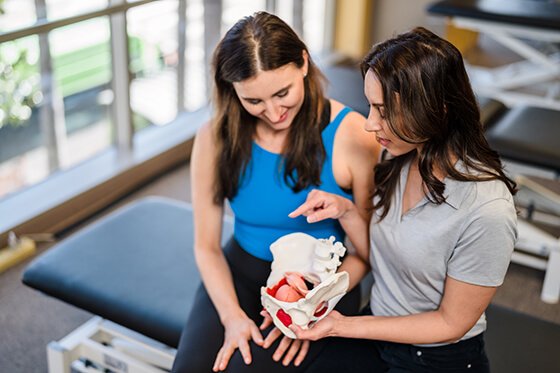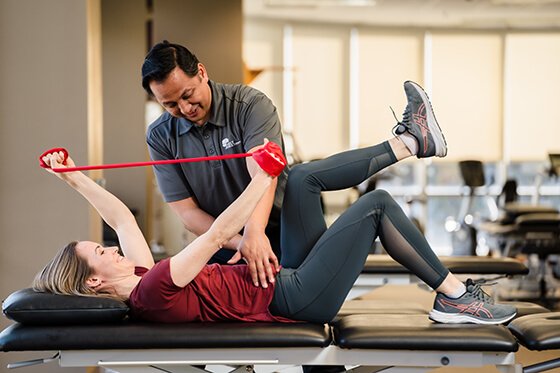Unlocking the secrets of pelvic health dysfunction in athletes
Why something so common is taboo in the world of sports
Posted 9/20/23 | 5 min. read
In the world of sports, achieving peak performance is a relentless pursuit.
Athletes push their bodies to the limit with intense impacts, injuries, sweat and grit.
When you think about sports injuries, a sprained ankle or a torn ACL likely comes to mind. Maybe even a concussion after a hard hit in football, or an injured knee after a hard blow in lacrosse.
The typical injuries one might say.
But have you ever heard of pelvic floor dysfunction (PFD)? If you have, you might not know how much it affects athletes.
It’s a shadowed topic of discussion that tends not to get too much attention because it involves more personal issues to the body.
Pelvic floor dysfunction is a term used to describe symptoms, signs and conditions due to impairments (or limitations) in the pelvic floor muscles.
The true number of people affected is unknown, but PFD is a condition that’s a growing problem among U.S. adults – about 25 million – both women and men.
Pelvic floor dysfunction in athletes is common, occurring in 33% of all female athletes and 50% of those who play high impact sports.* But that does not make it normal. It’s a deeply personal issue for many of us, and for that reason, no one talks about it.
But what’s the pelvic floor, you might ask?
It’s a group of muscles that sit in a bowl-like shape inside of your pelvis. It goes from your pubic bone to your tailbone and to the side of each hip bone.
It supports your abdominal and reproductive organs, stabilizes your back and hips, assists in sexual function, helps you empty your bowel/bladder and stops you from leaking urine, gas or bowel matter.
We’re still not done.
It also responds to changes in your intra-abdominal pressure which occurs with lifting, jumping, running, coughing, sneezing, breathing, etc.
So, your pelvic area is a lot more than just the bone structure.
It carries out many of your daily functions and is a supporter of some of your major organs.
Common symptoms of PFD
Pelvic floor dysfunction can display itself in many ways, and oftentimes people don’t realize they’re suffering from it.
Or, people may experience pain or other issues but won’t mention anything because of feelings of shame or embarrassment. In fact, 92% of female athletes never report their symptoms of PFD.*
For example, do you leak when you run? Approximately 48.58% of female adolescent athletes leak.**
Hunch over in pain or feel like you’re not completely emptying when having a bowel movement?
Cringe in discomfort rather than enjoy intimacy?
If so, it could mean that you suffer from pelvic floor dysfunction.
Some common symptoms of PFD are:
- Pelvic, low back, abdominal or lower extremity pain
- Urinary urgency, frequency or incontinence
- Fecal incontinence or gas
- Constipation
- Pelvic heaviness or bulging (“tampon falling out feeling”)
- Difficulty emptying bowel or bladder (having to splint or strain)
- Sexual dysfunction including pain and performance issues
- Hernias
- Muscle spasms in the abdomen
And, it’s important to note that none of this normal or anything you have to live with forever.
Common myths
Alright, you get a point for every myth about pelvic health you’ve heard before.
Here are some of the common misconceptions:
- The pelvic floor works in a vacuum.
- Kegels are the solution to incontinence and leakage.
- It’s normal to pee your pants as long as it’s only a little.
- You can only have pelvic floor problems if you have been pregnant or had a baby.
- You can only have pelvic floor problems if you’re a female.
If you haven’t caught on yet, none of these are true.
These myths also exist in the world of sports, and it’s time to shine a light on the pelvic health of athletes.
Considerations for athletic trainers – What to look out for
There’s a lot of reasons why athletes don’t speak up about the symptoms they experience, especially issues or pain related to pelvic health.
One of the biggest reasons is they might think nobody else on their team is dealing with the same thing.
Or, they might think they will have to sit the bench because of their pain.
They might think they can’t talk to their coach or athletic trainer about what’s going on either because, let’s face it, it can be awkward.
Imagine having to tell your athletic trainer the reason why you have to use the bathroom so much.
If you’re a female, try explaining to your male coach that you have to sit out of practice during menstruation because of the pain or inability to insert a tampon.
This is when silence seems like a lesser evil than pain, doesn’t it?
But this is where the expertise of athletic trainers come in.
Athletic trainers play a crucial role in the health and performance of athletes. While they are well-versed in addressing musculoskeletal issues, they’re also vigilant about athletes’ pelvic health.
So if you’re an athlete, your trainers should be keeping an eye on if you:
- Take frequent trips to the bathroom
- Avoid water before or during practice
- Are crossing your legs, keeping your hands at your private parts or want to sit down following a landing or sprint
- Avoid sitting
- Have a history of lower extremity injuries that may impact force absorption
- Experience low back, hip or pelvic girdle pain
- Participate in high durations of practice
- Avoid participating in sport during menstruation
And while the sports population is presumed to be ever fit and healthy, this is not always the case.
Pelvic floor dysfunction can affect any athlete, in any sport and in all ages and genders.
It’s worth noting, though, that pelvic floor dysfunction is more commonly seen in gymnastics, volleyball, cheerleading and even hockey. Anything that involves repetitive high impact.
Strain from jumping, running and even weightlifting can put pressure on the pelvic floor muscles over time, making them ineffective at managing the physical load on the body.
Risk factors
While further research is needed, there are some common reasons why athletes develop pelvic health dysfunction - especially at a young age.
The range is so wide, though, that it can be hard for athletic trainers or other health care specialists to determine how and when symptoms began.
Some common reasons athletes may develop pelvic floor dysfunction:
- Take oral contraceptives
- Have chronic constipation
- Take caffeinated or acidic supplements that can affect their bladder
- Have had a lower extremity injury impacting absorption or mobility through the foot, ankle, knee or hip (such as an ankle sprain or ACL repair)
- Play a high impact sport
- Have poor abdominal bracing strategies
- Have had a tailbone or lower back injury
- Practice more than 7.5 or 8 hours a week, especially in pubescent years
- Have a history of pregnancy or pregnancy loss
As always, athletic trainers should be mindful of their athletes’ medical history while they’re in season.
They should also try to note if other athletes are having the same symptoms but are hitting a dead end with their diagnosis.
A simple conversation can help someone open up more to what they’re going through and get to the bottom of what’s happening behind the scenes.
Building trust is the first step in an honest conversation.
Breaking the silence
Athletes are celebrated for their strength, determination and prowess in various sports.
Now they need to be touted for their courage, too.
Athletes may be scared to discuss the symptoms and issues they’re having, but finding someone who will listen and give them the confidence they need to keep moving forward with their sport is crucial.
If you have pain with inserting a tampon or problems with your menstrual cycle, talk to someone.
Pain with sexual intercourse? Talk to someone.
If you have frequent pain in your hips or lower back, talk to someone.
If you suffer from incontinence and are embarrassed to tell someone that you “pee your pants,” talk to someone.
Don’t suffer in silence, decrease your physical activity or stop playing your sport because of pelvic floor dysfunction. Proper education and care will help.
Treatment
The first step before receiving any treatment should be having the confidence to… you guessed it, talk to someone.
Bring the topic out in the open so you can find the best course of treatment for you.
If you start with your athletic trainer or primary care physician, they might recommend physical therapy.
Physical therapy can be an effective way to help with pelvic floor dysfunction.
Pelvic health physical therapy can look something like this:
- Strengthening of the weak pelvic, hip or abdominal muscles
- Coordination training for the pressure system such as your diaphragm, abdominal and pelvic floor muscles
- Movement re-training for sport-specific activity
- Patient education on posture, diet, pain science, etc.
There are more avenues of treatment, but these are the most commonly seen in athletes or patients with pelvic health dysfunction.
Proper pelvic health can enhance performance. Poor pelvic health in an athlete is the equivalent of a serious injury, like a torn ACL or sprained ankle.
Let’s step out of the dark and shine a light on pelvic health. Start the conversation today.
If you or someone you know are experiencing pelvic floor dysfunction symptoms, we can help.
You can quickly find a center near you or request an appointment to work with one of our experts.
* https://www.ncbi.nlm.nih.gov/pmc/articles/PMC9477953/
** https://www.ncbi.nlm.nih.gov/pmc/articles/PMC7931053/


